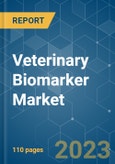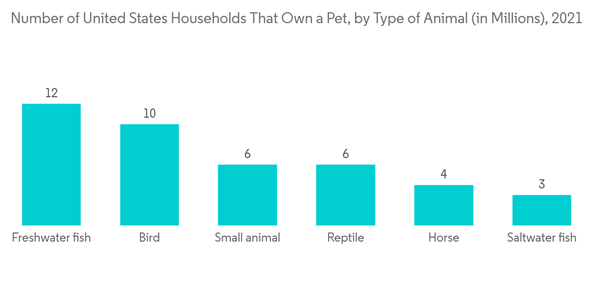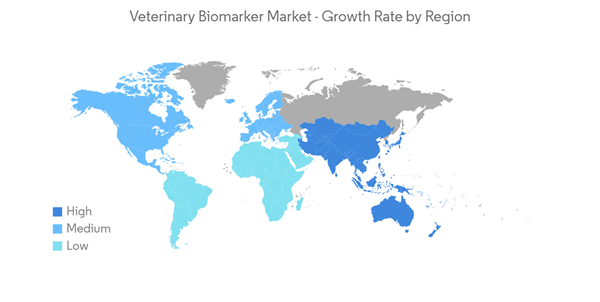The veterinary biomarker market is expected to register a CAGR of 11.8% over the forecast period.
The COVID-19 pandemic initially had a substantial impact on the veterinary biomarker market. The strict lockdowns and government regulations intended to slow down the spread of COVID-19 resulted in limited access to veterinary services. As per the study conducted by Merck Animal Health, a division of Merck & Co., Inc., in January 2022, the pandemic impacted many veterinarians, such as veterinary assistants, veterinary technicians, and practice managers, resulting in more than 90% of the shortage of qualified veterinary staff. Also, the pandemic caused severe mental distress amongst veterinarians, which rose from 6.4% in 2019 to 9.7% in 2021, as per the readings from Kessler Psychological Distress Scale, negatively impacting the market growth. However, the sales of veterinary products increased significantly during the pandemic. For instance, as per the American Veterinary Medical Association in August 2021, veterinary services showed a significant increase during the pandemic owing to a surge in the adoption of pets. Also, the pet owners were procuring higher-value veterinary products. Thus, the COVID-19 outbreak affected the market's growth adversely in its preliminary phase; however, the market is expected to gain traction due to the significant increase in the procurement of veterinary products globally.
Further, the high prevalence of chronic diseases such as cardiovascular diseases and cancer in animals, the high adoption rate, and the burgeoning population of companion animals are certain factors that are boosting the market growth. As per the American Veterinary Medical Association in April 2022, purebred dogs had 1.9 times higher relative risk of cancer in comparison to non-purebred dogs. In veterinary oncology, biomarkers are used for diagnosis, prognosis, staging, and tracking therapeutic outcomes. Such factors are likely to boost the adoption of veterinary biomarkers, thereby contributing to the growth of the market studied.
Moreover, the market for veterinary biomarkers is also expanding due to factors including the rising pet adoption rates and the expanding population of companion animals. For instance, as per the 2021-2022 American Pet Products Association (APPA) National Pet Owners Survey, approximately 70% of United States households own a pet, which equates to 90.5 million homes. Therefore, the increasing number of companion pet adoption is augmenting the demand for the veterinary biomarkers market.
Therefore, owing to the aforementioned factors, the market studied is anticipated to witness growth over the analysis period. However, the increasing pet care costs are likely to impede the market growth.
Furthermore, continuous product launches by major players in the market are positively affecting the segment's growth. For instance, in February 2022, VMRD, Inc., the developer and manufacturer of veterinary diagnostic test kits reagents, announced the launch of nucleic acid extraction kits to its molecular product line for gene sequencing and gene expression studies in animals. The kit provides rapid preparation of highly pure viral nucleic acids from tissue homogenates, swabs, serum, and plasma. Thus, owing to the product launches, th market studied is expected to have significant growth over the forecast period.
Therefore, the biomarkers, kits & reagents segment is expected to witness significant growth over the forecast period due to the abovementioned factors.
In North America, the United States accounts for most of the revenue share because of the presence of prominent players and the surging number of veterinarians in the country. As per the American Veterinary Medical Association (AVMA), the number of veterinarians has increased from 118,624 in 2020 to 121,461 in 2021. Also, the AVMA-recognized veterinary specialty organizations have increased from 13,539 in 2020 to 14,536 in 2021. Thus, the surging number of veterinarians and veterinary specialty organizations are the major factors that are expected to boost the regional market growth during the forecast period.
Furthermore, there has been a surge in the adoption of pet insurance services in the region which covers all veterinary treatments and medications. For instance, according to the survey conducted by the North American Pet Health Insurance Association, Inc., published in May 2022, around 4.41 million pets were insured in North America by the end of 2021, which was a 27.7% high in comparison to the previous year. Thus, the surging adoption of pet insurance services is expected to augment the veterinary biomarkers market growth in the region.
Therefore, owing to the aforesaid factors, the growth of the studied market is anticipated in the North America Region.
This product will be delivered within 2 business days.
The COVID-19 pandemic initially had a substantial impact on the veterinary biomarker market. The strict lockdowns and government regulations intended to slow down the spread of COVID-19 resulted in limited access to veterinary services. As per the study conducted by Merck Animal Health, a division of Merck & Co., Inc., in January 2022, the pandemic impacted many veterinarians, such as veterinary assistants, veterinary technicians, and practice managers, resulting in more than 90% of the shortage of qualified veterinary staff. Also, the pandemic caused severe mental distress amongst veterinarians, which rose from 6.4% in 2019 to 9.7% in 2021, as per the readings from Kessler Psychological Distress Scale, negatively impacting the market growth. However, the sales of veterinary products increased significantly during the pandemic. For instance, as per the American Veterinary Medical Association in August 2021, veterinary services showed a significant increase during the pandemic owing to a surge in the adoption of pets. Also, the pet owners were procuring higher-value veterinary products. Thus, the COVID-19 outbreak affected the market's growth adversely in its preliminary phase; however, the market is expected to gain traction due to the significant increase in the procurement of veterinary products globally.
Further, the high prevalence of chronic diseases such as cardiovascular diseases and cancer in animals, the high adoption rate, and the burgeoning population of companion animals are certain factors that are boosting the market growth. As per the American Veterinary Medical Association in April 2022, purebred dogs had 1.9 times higher relative risk of cancer in comparison to non-purebred dogs. In veterinary oncology, biomarkers are used for diagnosis, prognosis, staging, and tracking therapeutic outcomes. Such factors are likely to boost the adoption of veterinary biomarkers, thereby contributing to the growth of the market studied.
Moreover, the market for veterinary biomarkers is also expanding due to factors including the rising pet adoption rates and the expanding population of companion animals. For instance, as per the 2021-2022 American Pet Products Association (APPA) National Pet Owners Survey, approximately 70% of United States households own a pet, which equates to 90.5 million homes. Therefore, the increasing number of companion pet adoption is augmenting the demand for the veterinary biomarkers market.
Therefore, owing to the aforementioned factors, the market studied is anticipated to witness growth over the analysis period. However, the increasing pet care costs are likely to impede the market growth.
Veterinary Biomarker Market Trends
Biomarkers, Kits & Reagents Segment is Expected to Witness Significant Growth Over the Forecast Period
In recent years, there has been a surge in the adoption of biomarkers, kits & reagents for the treatment of animals, burgeoning the segment growth. For instance, as per the article published in MDPI in August 2022, with the potential of biomarkers to speed up disease diagnosis, monitor animal health effects, and increase animal welfare and productivity, new biomarkers hold the potential to revolutionize veterinary practice. In addition, because most cardiac disorders in companion animals are progressive, biomarkers of these disorders are crucial in veterinary medicine. According to the article published in Acta Scientific in June 2022, cardiac biomarkers such as pro-BNP and cardiac troponin I (cTnI) are being used either for diagnostic or therapeutic purposes in dogs and cats. Hence, the surging adoption of biomarkers for the diagnosis of treatment of diseases in animals is ultimately driving the segment's growth.Furthermore, continuous product launches by major players in the market are positively affecting the segment's growth. For instance, in February 2022, VMRD, Inc., the developer and manufacturer of veterinary diagnostic test kits reagents, announced the launch of nucleic acid extraction kits to its molecular product line for gene sequencing and gene expression studies in animals. The kit provides rapid preparation of highly pure viral nucleic acids from tissue homogenates, swabs, serum, and plasma. Thus, owing to the product launches, th market studied is expected to have significant growth over the forecast period.
Therefore, the biomarkers, kits & reagents segment is expected to witness significant growth over the forecast period due to the abovementioned factors.
North America is Expected to Dominate the Veterinary Biomarker Market
North America is expected to dominate the market owing to factors such as the high adoption of companion animals and high annual expenditure on these animals. For instance, as per the study conducted by the American Society for the Prevention of Cruelty to Animals (ASPCA) in May 2021, every 1 in 5 Americans owns a dog or cat. In addition, the annual spending on dogs and cats is significantly high in the United States.; according to the 2021-2022 National Pet Owners Survey, the United States spends approximately $458 on surgical vets, $287 on their food, and $242 on routine visits to the veterinarians every year. Thus, the high adoption of companion dogs and high annual expenditure on them are factors that augment the regional market growth.In North America, the United States accounts for most of the revenue share because of the presence of prominent players and the surging number of veterinarians in the country. As per the American Veterinary Medical Association (AVMA), the number of veterinarians has increased from 118,624 in 2020 to 121,461 in 2021. Also, the AVMA-recognized veterinary specialty organizations have increased from 13,539 in 2020 to 14,536 in 2021. Thus, the surging number of veterinarians and veterinary specialty organizations are the major factors that are expected to boost the regional market growth during the forecast period.
Furthermore, there has been a surge in the adoption of pet insurance services in the region which covers all veterinary treatments and medications. For instance, according to the survey conducted by the North American Pet Health Insurance Association, Inc., published in May 2022, around 4.41 million pets were insured in North America by the end of 2021, which was a 27.7% high in comparison to the previous year. Thus, the surging adoption of pet insurance services is expected to augment the veterinary biomarkers market growth in the region.
Therefore, owing to the aforesaid factors, the growth of the studied market is anticipated in the North America Region.
Veterinary Biomarker Market Competitor Analysis
The veterinary biomarker market is fragmented in nature due to the presence of several companies operating globally and regionally. The competitive landscape includes an analysis of a few international as well as local companies which hold market shares and are well known, including Zoetis Inc., Virbac, Veterinary Biomarkers, Inc., ACUVET BIOTECH, Merck & Co., Inc., IDEXX Laboratories, Inc., MI:RNA Diagnostics Ltd, Mercodia AB, Antech Diagnostics, Inc., Avacta Animal Health Limited, and VMRD, Inc.Additional benefits of purchasing the report:
- The market estimate (ME) sheet in Excel format
- 3 months of analyst support
This product will be delivered within 2 business days.
Table of Contents
1 INTRODUCTION
4 MARKET DYNAMICS
5 MARKET SEGMENTATION (Market Size by Value in USD million)
6 COMPETITIVE LANDSCAPE
Companies Mentioned (Partial List)
A selection of companies mentioned in this report includes, but is not limited to:
- Zoetis
- Virbac
- Veterinary Biomarkers, Inc.
- ACUVET BIOTECH
- Merck & Co., Inc.
- IDEXX Laboratories, Inc.
- MI:RNA Diagnostics Ltd
- Mercodia AB
- Antech Diagnostics, Inc.
- Avacta Animal Health Limited
Methodology

LOADING...










